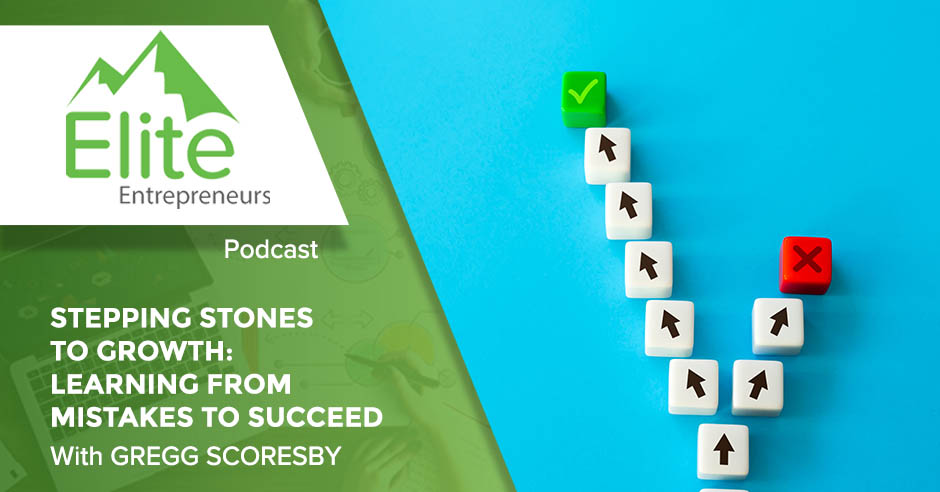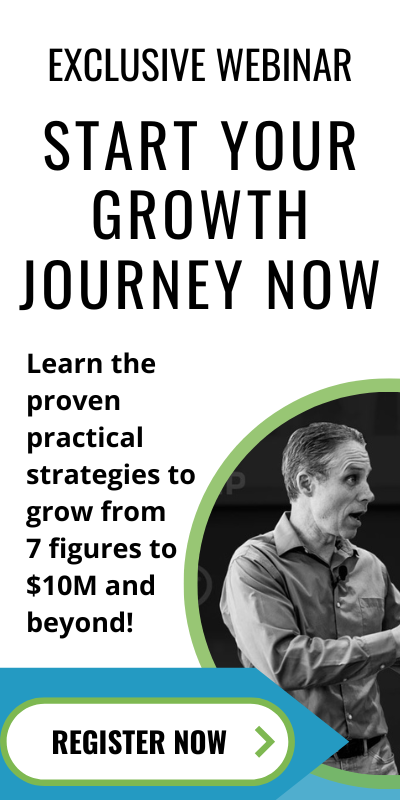Episode 154: Stepping Stones To Growth: Learning From Mistakes To Succeed With Gregg Scoresby
There’s no shortcut to success; like most successful individuals, one must traverse the long journey, full of blocks and hurdles. And it’s what makes the destination taste sweet. In this episode, Gregg Scoresby, the Founder and Managing Partner of PHX Ventures, brings the lessons he learned and the mistakes he embraced as the stepping stones to growth. He also talks about the role of culture in one’s ambition. Gregg’s wisdom brings so much value in this insightful episode. So, join us in this conversation, and today, we’ll turn these stumbles into success.
What the podcast will teach you:
- Embracing mistakes as stepping stones to growth
- Key lessons Gregg learned from the mistakes
- Entrepreneur’s ambition is dynamic
Resources:
LinkedIn: https://www.linkedin.com/in/greggscoresby/
Twitter: @GreggScoresby
PHX Ventures: https://www.phxventures.com/
—
Watch the episode here
Listen to the podcast here
I have another outstanding guest. Sometimes, I know the guest before he or she comes to spend time with us, and other times, this is the first time I’ve met that person. This is somebody that I’ve known for several years, and I appreciate him coming on. His name is Gregg Scoresby. He is a three-time successful entrepreneur.
He started, grew, and exited three businesses. The most recent one was a software company that grew to $50 million in annual recurring revenue and that he had successfully sold to a PE group. He’s become an investor. He’s out helping businesses who are trying to find that seed round of funds to get their growth started. Gregg, welcome to the show. I’m glad you’re here. I appreciate you doing this.
Thanks for having me. Thanks for all you’re doing for people pursuing their own entrepreneurial journey. I appreciate all you do for all the entrepreneurs out there.
It’s rewarding. It’s fun to talk to great people like you along the way. Why don’t you give all of us a little bit more context about your venture fund and the activities that you’re involved with so they have some context? We’ll get into your entrepreneurial scaling lessons after that.
PHX Ventures is a seed-stage venture capital firm investing in post-revenue B2B software companies. Our entry point usually looks like companies that are between $300,000 and $1 million, growing at 15% to 20% month over month. There’s some good growth happening. We’ll usually write a one to $1.5 million check to lead a $2 million to $3 million seed round. That would be a typical deal for us. We’re exclusively focused on B2B software. We don’t have to do only Arizona deals, but the majority of our relationships here in Arizona. We end up having a lot of deal flow in Arizona. We think there’s a real opportunity to compound talent and capital in our little corner of the world here.
We appreciate what you’re doing for our little corner of the world. This happens to be my corner, which is why we know each other. We both have played in this little sandbox here in the desert for the last several years. Before you were investing in companies, you were leading a high-growth software company and had to learn lots of lessons as the business owner and the founder. I’d like to get into some of those lessons.
We talked about a couple of things before we hit record, but I don’t want to be prescriptive. Let’s open it up. As you think about it, not the zero to million part of that journey, which I honor and respect greatly, but when you started to have some success, things started to take off, and you had to make a transition from founder-entrepreneur to business-building CEO.
This was your third business. You came at it with some experience, but there’s still something that happens when you get into that mode of, “Now we need to scale this thing.” As you think back on that time, what are some of the key lessons that you learned or some of the key learnings that stand out for you?
Something I care deeply about as an investor and an operator is I love the company-building journey. I love the lessons that founders share on their own company-building journey. I’m excited to be part of that. I’ve got 2 or 3 I’ll share here, but most lessons for me occurred around mistakes I’ve made. That’s where a lot of learning happens for me and most of us.
When I look back on some of those critical moments where I made a mistake or, in hindsight, should have made a different decision, most of the time, they were decisions around not having people in the right roles at the right time and doing the right things. One lesson is I never felt like I spent too much time recruiting.
I joked over the years that, at CampusLogic in particular, I was never not the Chief Recruiting Officer. We had a great talent acquisition team that helped with all that. Especially for key roles, I spent a lot of time. Sometimes, I would spend an entire week, all hours of the week, 40 hours a week in recruiting-related activities, sourcing on LinkedIn, or doing interviews. Sometimes, that is what’s required. Getting the right people in the right roles and doing the right things at the right time is something that I never felt like I was too focused on. It was always needed to do more of. It’s being intentional about who we hire, what impact we expect them to have, and what’s the key metric or metrics.
Hopefully, it’s only 1 or 2 metrics that we expect them to move in the business. Being clear about that, supportive along the journey, and direct and kind. We have to find that balance. We need to be direct in our communication. That’s how we get people in the right roles, keep them in those roles, and help develop them over time so that we can compound talent inside of our companies.
We need to be direct in our communication. That's how we get people in the right roles, keep them and help develop them to compound talent inside our companies. Share on XI want to go back to something you said early on about the Chief Talent Officer. You talked about sourcing on LinkedIn. I remember that in early March of 2020, you came in as a guest, speaker, and sharer to our high-level mastermind group on our Elite community. You shared a practice that you engaged in consistently on LinkedIn to find some of those key roles. I would love it if you wouldn’t mind sharing briefly what specifically you did. When you had a need for a specific role, how did you go about looking for that person on LinkedIn? What were some of the tactics you used there?
For starters, one of the things I would do is meet my Chief Operating Officer at CampusLogic, Chris Chumley. Chris and I would meet at the end of every year, and sometimes, we would do this quarterly, especially at the end of every year. We would talk about some of the key roles we were going to need next year. In order for us to hit our plan, what were the missing pieces? We spend a lot of time on financial proformas. I don’t think most of us, as founders, spend enough time on organizational proformas. How is this organization going to evolve and grow, and what’s this going to look like over the next several months? Understanding those roles is important.
I would start early, reach out on LinkedIn, and try to build not just the job spec but what the profile of this person looks like. If this is a Head of Finance, for example, what are the skills, attributes, or experiences I want them to have? They need to have had growth company experience in a software context. They need to be a good fit with our values. We were venture-backed companies. They need to have experience working with venture capital firms. I get a general idea of the spec.
I would start doing keyword searches and then reach out to people. A lot of times, I would say, “I’m thinking about hiring this person later in the year. I would love to talk to you. Even if you’re not available now, can we have a conversation?” Most of the time, when a CEO or founder reaches out to someone and says, “This is what I want to talk to you about. This is why I think you’re a good fit. There’s a level of specificity. Even though you may not be looking, would you be open to a short conversation?” most of the time, they say yes.
In those conversations, I wouldn’t find someone who was ready to come join my company, or they weren’t a good fit. I would learn something from those conversations. I also ought to be looking for this other attribute on that. Those conversations were instructional. I would be talking to 20 or 30 people in 20 to 30-minute increments to start to build a pipeline of these people.
A lot of business owners, CEOs, or founders don’t appreciate this, but top talent gets outreach all the time from recruiters. They rarely get outreach from someone who has a CEO or founder title. The response rate is high. If you’ll do the work to think about what you want, make a specific ask, and have a conversation about that, there’s so much learning. A lot of times, you’ll find people in those conversations, but even if you don’t, you’ll get smarter about what you’re looking for. Laying the groundwork to make sure you are being thoughtful and intentional about getting the right people in the right roles starts with doing a lot of the legwork there.
I love that you backed me up with my question, not supporting me, but you zoomed out and said, “Before we get into the LinkedIn activity, let’s talk about the intentionality of the design of our team, where we’re going over the next several months, and how we need to be thinking now about those key roles.” That’s when you started to reach out on LinkedIn. It wasn’t random reaching out to the types of roles that you already have. It was thoughtful and strategic to reach out to people who might help you fill future needs that you had identified.
I took this away from the first time I heard you share it a few years ago. At a minimum, you were likely going to learn something about other ways to view success in those roles that you were learning about. That was great. On the upside, maybe that person was a good candidate for the role. I’m curious. Did they ever refer to other people that they’d say, “You should talk to so-and-so?”
The majority of people that I recruited on my executive team I met on LinkedIn or were a referral from someone I met on LinkedIn. I mentioned Chris Chumley. I was looking for a Head of Product. I wasn’t looking for a CEO. This is an example of this, but we were getting into revenue. I had some problems in my product development. I’m not a technical founder. I understood our market and the opportunity well, but I needed a partner who understood how to build software at scale. We were solving a complex problem in higher education.
I reached out to someone who I was excited about. She said, “There are two problems. 1) I’m in Philadelphia, and I’m not going to move to Phoenix. 2) There’s someone better than me, and it’s a person I used to report to. Let me introduce you to him.” She introduced me to Chris. That’s how I met Chris. I ended up changing the job spec.
Chris said, “I’m interested, but what I found would be valuable, not just the job spec, but how I organize the company. I’m interested, and this isn’t a requirement for me, but ideally, I would own product engineering and customer success because I like the whole loop of building a product. We implement the product. The customer either doesn’t like something about the product or the way it was implemented, and I want that feedback to come back in.”
That’s how we organized. For all of our years at CampusLogic, we organized because I learned that from him in the recruiting process. Otherwise, I would’ve probably hired a director or Head of Product. That’s an example where not only did I get a referral, but the ultimate referral, I hired Chris, but I also got so much learning about how he thought about organizational design and structure. It ended up being a great partnership. He’s now an operating partner at PHX Ventures. We’ve got the band back together here, working together again.
I love that story for many reasons, but you did the work to reach out to the person who you were talking to and said, “You should talk to this person over here.” This person is part of your core band who’s back together, which is amazing. For everyone who’s mentally thinking, “I should spend some more time on LinkedIn,” yes, if it’s intentional. If you do it the right way, it’ll be hugely valuable to you. If you spend time on LinkedIn and hope that something happens coincidentally, that’s not the way it’s going to work for you.
I’d love to talk about another lesson here, but before we go to the next lesson, I did want to say sometimes we spend a lot of time on activities. I’m describing spending a lot of time on this activity. It can sound massively inefficient potentially to people. What’s inefficient is getting the wrong person in that role. I want to get to know people over a long period of time. I want to learn and get more than add bats with them and not have hiring be transactional. I want it to be relational.
I’ve never regretted spending time doing the heavy lifting around getting to know people in the recruiting process. That allows me to make the best decision, but it also allows people to hit the ground running and continue. It feels inefficient on the front end, but what it does is it creates a compounding effect in the business and allows you to build relationships with your people and retain top talent, which is the growth lever that we need to scale our companies.
It’s impactful to learn that you share that lesson as a high-growth software founder. I’ve seen it over and over again in those software companies, especially if they’re venture-backed. It’s like, “We have to get people in here. We have to do it now.” Your proactive, intentional way of building relationships over time allowed you to bring people in that stack and the right people that helped you be successful in growing that.
It’s not easy to pull that off in that high-pressure, high-growth environment. It is noteworthy that’s the approach that you took. Let’s get to your next lesson. I know you have more than a couple, but let’s get to at least another one here. As you’re thinking about key things that you learned to be able to grow your business, what else comes to mind?
This is one thing I credit to receiving a lot of influence from you and Elite, but this was in 2015 or 2016. We went through Elite called Elite Forum. We went through this experience. Chris was there with me, and a couple of other key leaders were there. What stuck with me was the need to not only get clarity on purpose, mission, and values but to never stop communicating and engaging around those things. It is true as predicted. It can be tiresome to communicate those things, but looking back, it was never too much.
It’s part of getting clarity around our why. Hopefully, every person who worked with me at CampusLogic says, “What’s the purpose? Why do we exist at CampusLogic?” Hopefully, they can say, “We exist to change.” We want to help schools change lives. That’s what we want to do as our purpose. That’s enduring. That’s a 100-year goal. That’s what we want to do. Mission, what do we want to do?
One thing I learned from Elite that I certainly believe in is I love time-bound missions. We want to do X by Y thing. We wanted to get to 600 colleges and universities at $50,000 in average revenue per account and $30 million in revenue. At the time, we made that mission, and we want to do that by 2020. At the time we made that goal, we were at $700,000 or $800,000 in annual recurring revenue. On July 1st, 2020, after working on this for several years, we hit that on that date. We closed the deal and got the deal done in early July 2020. That allowed us to get over that threshold.
If you look back, it’s like, “That was magically happened.” No, it wasn’t magic. We hammered on this over. Every two weeks in our company meeting, we talked about this. We’re like, “Our purpose is to help schools change lives. Our mission is to get to 600 schools by 2020.” We had 20 or 30 schools at the time. To drive, organize around that, push toward that, and expand our product line to be able to support those schools in their effort to change students’ lives, those things came together and allowed us to be successful.
How are we going to behave along the way? Values have been important. Hopefully, our employees, over the years, could recite some of those values because those became how we governed the company and how we are going to work together. What behaviors are we going to reward? How are we going to hold each other accountable for these behaviors, and how do we interact with each other? That combination of being constantly communicative, deliberate, and intentional around purpose, mission, and values with a regular cadence were things that I credit a lead for. It became a fundamental part of the fabric of CampusLogic.
It is fascinating, whether it’s a software company or a service company, in some other type of service, when there are people involved and the only way to grow this thing is to add more people to the organization, that core identity and specific destination-oriented mission provides the clarity. Between the identity and the clarity, it does a lot to bring a number of people together and align them to something. That’s a lesson that I keep seeing played out. I appreciate you mentioning your own version of that story. That was awesome.

Stepping Stones To Growth: The only way to grow is to add more people to the organization.
Nobody ever says, “One thing about my company is all my people were aligned.” There’s always work to do to create more alignment. It’s not surprising because people are working hard with good intentions. It’s easy to get distracted and disoriented. What are we doing again? Having clarity around purpose, mission, and values and being communicative about it is what allows people to stay. They were like, “I have to remember. Now, we’re doing this. We’ve always been doing this, but I can’t lose sight of the goal here.” As a company gets bigger, there’s a never-ending effort to keep our people aligned.
We have time for one more if you have another lesson you’d like to share.
Let me think about a couple of things around mistakes. One thing that we want to leave room for is I’ve been thinking a lot about ambition. When we’re building our companies, our ambition levels can change. That’s good. Sometimes, people start to feel like they might lose steam, but a lot of people who are building companies, if you get the culture right, what you’ll find is that it’s not exhausting. It doesn’t suck your ambition. It fuels your ambition if you get the culture right.
Company building is always hard, but it’s a lot harder when you don’t have the culture right. This is more for me checking my ambition and being thoughtful about what I am feeling now. What am I thinking about now? What do I want to build there? What’s possible here? If you are in a period of time where you’ve got expanding ambition because you like what is going on. The culture’s good. Your customers like your product. Things are working. That’s not the time to coast. That’s the time to lean into growth. If you’re ever feeling zapped from ambition, that might be the time to reset and go, “How do we reset things and get growth inflecting again?”
When the culture is good, your customers like your product, and things are working or your service, that's not the time to coast but the time to lean into growth. Share on XAmbition to me is usually, and how I’m feeling about my own ambition is an indicator of something else. It’s an indication of what I’m experiencing in the market or culture. The world needs more ambitious entrepreneurs. The world is a better place with more ambitious entrepreneurs. I do believe that people who build sustainable growth companies can have as much impact as any other institution out there on individuals, families, and communities.
The world needs more ambitious entrepreneurs, but if you or a founder ever feel their ambition is waning, it’s probably more of a symptom than a root cause because ambition is dynamic. That’s the takeaway. Sometimes, people will say, “That person doesn’t have enough ambition.” I usually think the root cause is not that they don’t have enough ambition. Ambition is symptomatic.
If you fix the root cause, ambition can inflect and expand. As an investor, the top companies we’ve invested in will have one thing in common. The entrepreneur’s and founder’s ambitions have expanded from what their original vision was. They’re like, “This something new is possible. I thought this was possible, but now we can do even more.”
I’ve seen that with the companies we’ve invested in. We talk about ambition as a static variable. It’s a dynamic variable and can change over time. One thing for your readers to think about is, “What am I feeling right now with where I want to take this company, and how might this be a symptom of something else? Let me fix the other thing, and my ambition, excitement, and enthusiasm can inflect again about what’s possible in my company.”
I misintroduced you earlier, Gregg. I should have introduced you as Dr. Scoresby. That was PhD level stuff right there. That was higher math. I can’t help but comment on it. You’re that thoughtful about how these things work. It takes a ton of critical thinking about your own experience in the process and now observing other founders in their growth to see that variable of ambition as being more dynamic than static.
It’s not the only place that you pointed out, but you included some of the internal health, organizational culture, or health kinds of things as either contributing to that ambition or depleting it because something is off. When we’re not feeling ambitious, where’s it off? Is it in the market? Is it with our team? Is it with me personally? I’m not taking care of myself, but sometimes ambition does get off. That’s not a static input or variable. It can be a dynamic output of all the other things going on in your life.
If I fix those other things, my ambition can grow. I do think the founder’s ambition is the indicator of what’s possible in a company. If a CEO or the founder’s ambition wanes, that’s going to affect the rest of the company. There’s a lot of opportunity there. I’ve made a lot of mistakes in company building. That’s given me a lot of time to be introspective. I love company building. It’s the thing that extends across my own entrepreneurial journey and investing journey, even as an investor.

Stepping Stones To Growth: Founder ambition is like the indicator of what’s possible in a company.
A lot of times, people think investing at the seed stage or early stage is about returns. They are, but returns are the output. What I want is to help people build companies that are healthy, high-growth, and sustainable. I put all the pieces in place that can help a company grow. A company is worth a lot of money down the road and delivers great investment returns. That’s the outcome that happens when it happens, but it starts with building healthy, high-growth, sustainable companies that make a difference in the world.
Gregg, it’s been a pleasure. Every time I get a chance to talk with you, I leave lifted in some way. I appreciate your time and the insights that you shared from your own journey. If people get all excited about learning from Dr. Scoresby, how would they do that? How would they learn more about what you’re doing with PHX Ventures? How would they learn or connect with you? What’s the best way for them to do that?
I’m not active on any social media other than LinkedIn. You can find PHX Ventures. It’s PHXVentures.com. You can find our website there. You can search for that on LinkedIn. You’ll find us and it’s Gregg Scoresby on LinkedIn. I try to write something about company building once a week, in part because, on LinkedIn, I don’t publish on Medium, Substack, or anywhere else, but I like it, and it’s on my mind.
I’ll usually write something that’s been on my mind, something I’ve learned and observed either as a founder or as an investor watching other founders build their companies. I try to write once or twice a week and publish there. I try to respond to people who message me on LinkedIn, but that’s always the best format for me.
As one who enjoys your weekly posts or however often you get to them, I’ll commend people to find you. We find him on LinkedIn and his company-building posts. It’s not always about the things we’ve talked about now, but it’s about his interest in the world of supporting businesses in their company, building through his venture fund, but great lessons learned. I highly recommend people check it out. Gregg, thank you again for being here. It’s been an absolute pleasure and great stuff you shared.
Thank you for having me, and thanks again for all you’re doing.
For everyone else, please like, share, subscribe, and do all those things so that we can help as many seven-figure business owners as possible and get lessons from people like Gregg and the other great guests we’ve had. Thanks for being here and we’ll see you in the next episode.
Important Links
- PHX Ventures
- Gregg Scoresby – LinkedIn
About Gregg Scoresby
 I’ve started, scaled, and sold 3 successful companies in Arizona. My last company, CampusLogic, became one of Arizona’s fast-growing, largest, and well-funded software companies. I’ve tried hard to build high-performing teams, category-defining products, and inclusive cultures. I feel most at home when I am talking to other company builders.
I’ve started, scaled, and sold 3 successful companies in Arizona. My last company, CampusLogic, became one of Arizona’s fast-growing, largest, and well-funded software companies. I’ve tried hard to build high-performing teams, category-defining products, and inclusive cultures. I feel most at home when I am talking to other company builders.
My current aspiration is to close the venture deficit in Arizona. I am using my capital, connections, and operating experience to help ambitious software entrepreneurs build healthy, high-growth companies in Arizona. I will invest in at least 30 Arizona software companies by 2030. I want to become the most active and impactful SaaS investor in Arizona.
Want to listen to more? View all episodes here >



